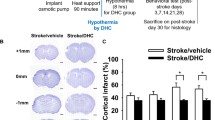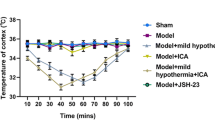Abstract
Ischemic injury leads to cell death and inflammatory responses after stroke. Microglia especially play a crucial role in this brain inflammation. Targeted temperature management (TTM) at 33 °C has shown neuroprotective effects against many acute ischemic injuries. However, it has also shown some adverse effects in preclinical studies. Therefore, we explored the neuroprotective effect of TTM at 36 °C in the ischemic brain. To confirm the neuroprotective effects of hypothermia, mice were subjected to a permanent stroke and then treated with one of the TTM paradigms at 33 and 36 °C. For comparison of TTM at 33 and 36 °C, we examined neuronal cell death and inflammatory response, including activation and polarization of microglia in the ischemic brain. TTM at 33 and 36 °C showed neuroprotective effects in comparison with normal body temperature (NT) at 37.5 °C. Mice under TTM at 33 and 36 °C showed ~ 45–50% fewer TUNEL-positive cells than those under NT. In IVIS spectrum CT, the activation of microglia/macrophage in CX3CR1GFP mice reduced after TTM at 33 and 36 °C in comparison with that after NT on day 7 after ischemic stroke. The number of Tmem119-positive cells under TTM at 33 and 36 °C was ~ 45–50% lower than that in mice under NT. TTM at 33 and 36 °C also increased the ratio of CD206-/CD86-positive cells than the ratio of CD86-/CD206-positive cells by ~ 1.2-fold. Thus, TTM at 33 and 36 °C could equivalently decrease the expression of certain cytokines after ischemic stroke. Our study suggested that TTM at 33 or 36 °C produces equivalent neuroprotective effects by attenuating cell death and by altering microglial activation and polarization. Therefore, TTM at 36 °C can be considered for its safety and effectiveness in ischemic stroke.







Similar content being viewed by others
Data Availability
The datasets generated during and/or analyzed during the current study are available from the corresponding authors on reasonable request.
References
Dumitrascu OM, Lamb J, Lyden PD. Still cooling after all these years: meta-analysis of pre-clinical trials of therapeutic hypothermia for acute ischemic stroke. J Cereb Blood Flow Metab. 2016;36(7):1157–64. https://doi.org/10.1177/0271678X16645112.
Wu TC, Grotta JC. Hypothermia for acute ischaemic stroke. Lancet Neurol. 2013;12(3):275–84. https://doi.org/10.1016/S1474-4422(13)70013-9.
Choi HA, Badjatia N, Mayer SA. Hypothermia for acute brain injury—mechanisms and practical aspects. Nat Rev Neurol. 2012;8(4):214–22. https://doi.org/10.1038/nrneurol.2012.21.
Nielsen N, Wetterslev J, Cronberg T, Erlinge D, Gasche Y, Hassager C, et al. Targeted temperature management at 33°C versus 36°C after cardiac arrest. N Engl J Med. 2013;369(23):2197–206. https://doi.org/10.1056/NEJMoa1310519.
Basto FM, Lyden P. Hypothermia in acute ischemic stroke therapy. Handb Clin Neurol. 2018;157:823–37. https://doi.org/10.1016/b978-0-444-64074-1.00051-3.
Kurisu K, Yenari MA. Therapeutic hypothermia for ischemic stroke; pathophysiology and future promise. Neuropharmacology. 2018;134(Pt B):302–9. https://doi.org/10.1016/j.neuropharm.2017.08.025.
Callaway CW, Donnino MW, Fink EL, Geocadin RG, Golan E, Kern KB, et al. Part 8: Post-cardiac arrest care: 2015 American Heart Association Guidelines Update for Cardiopulmonary Resuscitation and Emergency Cardiovascular Care. Circulation. 2015;132(18 Suppl 2):S465–82. https://doi.org/10.1161/cir.0000000000000262.
Lee JH, Lim J, Chung YE, Chung SP, Park I, Kim CH, et al. Targeted temperature management at 33°C or 36°C produces equivalent neuroprotective effects in the middle cerebral artery occlusion rat model of ischemic stroke. Shock. 2018;50(6):714–9. https://doi.org/10.1097/shk.0000000000001106.
Ahmed AI, Bullock MR, Dietrich WD. Hypothermia in traumatic brain injury. Neurosurg Clin N Am. 2016;27(4):489–97. https://doi.org/10.1016/j.nec.2016.05.004.
Liu L, Liu X, Wang R, Yan F, Luo Y, Chandra A, et al. Mild focal hypothermia regulates the dynamic polarization of microglia after ischemic stroke in mice. Neurol Res. 2018;40(6):508–15. https://doi.org/10.1080/01616412.2018.1454090.
Lee JH, Wei ZZ, Cao W, Won S, Gu X, Winter M, et al. Regulation of therapeutic hypothermia on inflammatory cytokines, microglia polarization, migration and functional recovery after ischemic stroke in mice. Neurobiol Dis. 2016;96:248–60. https://doi.org/10.1016/j.nbd.2016.09.013.
Truettner JS, Bramlett HM, Dietrich WD. Posttraumatic therapeutic hypothermia alters microglial and macrophage polarization toward a beneficial phenotype. J Cereb Blood Flow Metab. 2017;37(8):2952–62. https://doi.org/10.1177/0271678X16680003.
Lee JH, Yoon EJ, Seo J, Kavoussi A, Chung YE, Chung SP, et al. Hypothermia inhibits the propagation of acute ischemic injury by inhibiting HMGB1. Mol Brain. 2016;9(1):81. https://doi.org/10.1186/s13041-016-0260-0.
Kim JY, Kim N, Zheng Z, Lee JE, Yenari MA. 70-kDa Heat shock protein downregulates dynamin in experimental stroke: a new therapeutic target? Stroke. 2016;47(8):2103–11. https://doi.org/10.1161/STROKEAHA.116.012763.
Zhao CC, Wang CF, Li WP, Lin Y, Tang QL, Feng JF, et al. Mild hypothermia promotes pericontusion neuronal sprouting via suppressing suppressor of cytokine signaling 3 expression after moderate traumatic brain injury. J Neurotrauma. 2017;34(8):1636–44. https://doi.org/10.1089/neu.2016.4759.
Liu B, Wang L, Cao Y, Xu W, Shi F, Tian Q, et al. Hypothermia pretreatment improves cognitive impairment via enhancing synaptic plasticity in a traumatic brain injury model. Brain Res. 2017;1672:18–28. https://doi.org/10.1016/j.brainres.2017.07.008.
Yenari MA, Han HS. Neuroprotective mechanisms of hypothermia in brain ischaemia. Nat Rev Neurosci. 2012;13(4):267–78. https://doi.org/10.1038/nrn3174.
Kim JY, Kim N, Lee JE, Yenari MA. Hypothermia identifies dynamin as a potential therapeutic target in experimental stroke. Ther Hypothermia Temp Manag. 2017;7(3):171–7. https://doi.org/10.1089/ther.2017.0005.
Rivest S. Regulation of innate immune responses in the brain. Nat Rev Immunol. 2009;9(6):429–39. https://doi.org/10.1038/nri2565.
Kim JY, Kim N, Yenari MA. Mechanisms and potential therapeutic applications of microglial activation after brain injury. CNS Neurosci Ther. 2015;21(4):309–19. https://doi.org/10.1111/cns.12360.
Van Hemelrijck A, Vermijlen D, Hachimi-Idrissi S, Sarre S, Ebinger G, Michotte Y. Effect of resuscitative mild hypothermia on glutamate and dopamine release, apoptosis and ischaemic brain damage in the endothelin-1 rat model for focal cerebral ischaemia. J Neurochem. 2003;87(1):66–75. https://doi.org/10.1046/j.1471-4159.2003.01977.x.
Zhao H, Shimohata T, Wang JQ, Sun G, Schaal DW, Sapolsky RM, et al. Akt contributes to neuroprotection by hypothermia against cerebral ischemia in rats. J Neurosci. 2005;25(42):9794–806. https://doi.org/10.1523/JNEUROSCI.3163-05.2005.
Wang Q, Tang XN, Yenari MA. The inflammatory response in stroke. J Neuroimmunol. 2007;184(1–2):53–68. https://doi.org/10.1016/j.jneuroim.2006.11.014.
Marehbian J, Greer DM. Normothermia and stroke. Curr Treat Options Neurol. 2017;19(1):4. https://doi.org/10.1007/s11940-017-0437-6.
Hong JM, Lee JS, Song HJ, Jeong HS, Choi HA, Lee K. Therapeutic hypothermia after recanalization in patients with acute ischemic stroke. Stroke. 2014;45(1):134–40. https://doi.org/10.1161/strokeaha.113.003143.
Kammersgaard LP, Jørgensen HS, Rungby JA, Reith J, Nakayama H, Weber UJ, et al. Admission body temperature predicts long-term mortality after acute stroke: the Copenhagen Stroke Study. Stroke. 2002;33(7):1759–62. https://doi.org/10.1161/01.str.0000019910.90280.f1.
Connolly ES Jr, Rabinstein AA, Carhuapoma JR, Derdeyn CP, Dion J, Higashida RT, et al. Guidelines for the management of aneurysmal subarachnoid hemorrhage: a guideline for healthcare professionals from the American Heart Association/american Stroke Association. Stroke. 2012;43(6):1711–37. https://doi.org/10.1161/STR.0b013e3182587839.
Funding
This study was supported by a grant from the National Research Foundation of Korea (NRF) grant funded by the Ministry of Science, ICT & Future Planning (NRF-2016M3C7A1905098 to JEL and NRF-2018R1C1B6006159 to JSY) and a faculty research grant from Yonsei University College of Medicine for 2019 (6–2019-0188).
Author information
Authors and Affiliations
Corresponding authors
Ethics declarations
Ethical Approval
All animal experiments were performed in accordance with the guidelines of the Institutional Animal Care and Use Committee (IACUC) of Yonsei University Health System and the National Institutes of Health guidelines.
Conflicts of Interest
The authors declare no competing interests.
Additional information
Publisher's Note
Springer Nature remains neutral with regard to jurisdictional claims in published maps and institutional affiliations.
Jong Youl Kim and Ju Hee Kim are co-first authors
Rights and permissions
About this article
Cite this article
Kim, J.Y., Kim, J.H., Park, J. et al. Targeted Temperature Management at 36 °C Shows Therapeutic Effectiveness via Alteration of Microglial Activation and Polarization After Ischemic Stroke. Transl. Stroke Res. 13, 132–141 (2022). https://doi.org/10.1007/s12975-021-00910-8
Received:
Revised:
Accepted:
Published:
Issue Date:
DOI: https://doi.org/10.1007/s12975-021-00910-8




